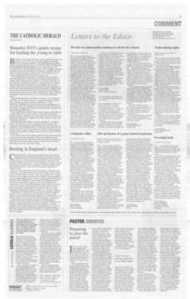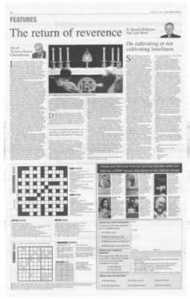Page 9, 15th August 2008
Page 9

Report an error
Noticed an error on this page?If you've noticed an error in this article please click here to report it.
Tags
Share
Related articles
No Escape
It Is Wrong To Invoke An Imaginary ‘spirit Of John Henry...
Are You A Deontologist?
When Is Spin A Serious Sin .
Charitable Blogging
Forget Vatican roulette
Quentin de la Bedoyere Science and Faith
whether or not a sincere Catholic agrees or disagrees with the papal teaching on contraception there is, I would claim, an obligation to give it full, due weight. In other words he or she must read and examine the teaching with a real intention to conform to the mind of the Magisterium. Only then will those who disagree be ready, as Newman suggested, to defend their decision in front of the Judgment Seat.
The element which I want to look at is Natural Family Planning (NFP), which is specifically acceptable in the papal teaching. The method suffers from a good deal of prejudice because of its history. It was once commonly known as "Vatican roulette". This has not been applicable for years. NFP is established as a reputable method of fertility regulation with safety rates which compare favourably with other methods. And it is used by many nonCatholics who like its natural character and dislike the hormonal or instrumental interference of other methods.
NFP is based, of course, on the fact that a woman is only fertile at one point in her cycle. Provided that this can be identified, and the full marital embrace avoided over that time, conception will almost never take place.
Initially (I speak of the 1930s rather than classical times when it was first recognised) this could only be calculated by taking the longest and shortest cycles which a woman exhibited. In the case of irregular cycles the period of abstinence could be very long indeed, and, even in the best cases, there was a statistical risk of concepdon .
By the 1950s, when I was married, it had been observed that the end of the fertile period could be established by the small rise in body temperature which occurred after ovulation. This was a great improvement but not infallible. On one, occasion my wife had to get up in the early hours, and switched on the electric blanket on her return. We nicknamed that child "Morphy Richards". And the first "safe" period in the month still had to be calculated on the probabilities.
By the 1960s it was well understood that certain physical changes, recognisable by a woman trained in the method, could indicate the onset of ovulation. It has been called different names but generically it is known as the sympto-thermic method (a combination of biological symptoms and a rise in body temperature). Various detailed refinements have been introduced but it is the basic method used today.
The ideal users of the method are well-motivated, stable couples, leading a regular life, sensitive to each others' needs and able to communicate well on sexual matters. That may sound a demanding recipe but in fact the conditions are fulfilled by many Catholic couples, and mixed marriages especially those where respect for the other's beliefs is high.
Like any other method of avoiding conception, there are disadvantages. Lactation (during which a woman is usually infertile, and normally particularly anxious to avoid conception) can cause problems, as can the irregularities which may accompany the approach of the menopause. Shift working can interfere with the measurement of the rise in temperature following ovulation, and so can ailments and certain medications. Some women find the methods of detecting symptoms unaesthetic.
Most prominent is the element which requires eschewing the full marital embrace for eight to 10 days each month. Since ovulation is related to the end of the month, women with short cycles can find their infertile days very restricted. This is a subjective, but nevertheless real issue. Sexual temperaments differ. For some couples it is an advantage. They would claim that experiencing the NFP is a do-it-yourselves method, in one sense of the phrase. But make no mistake, it needs proper training (your parish priest or local Marriage Care should be able to recommend sources). A woman will need at least three months to learn her symptoms with confidence, so it's folly to wait until the wedding night. And her husband should fully understand what is involved.
Working within the general principles I have described, there are different detailed approaches and it is important to be satisfied that the one chosen is the most suitable for a particular couple. Some personal research may be needed here.
But I would like to leave a question in the air, if only for bloggers at www.secondsight.com. Notwithstanding the acceptance of its use for adequate reasons by the Magisterium, is its systematic employment any more or less artificial than barrier or hormonal methods? (By the way, if you write to me, and I always benefit from your letters, I only assume that you would like an acknowledgment when you enclose an SAE.)
blog comments powered by Disqus

















